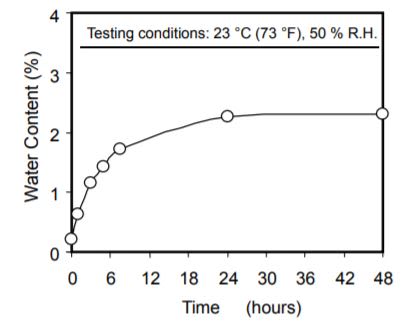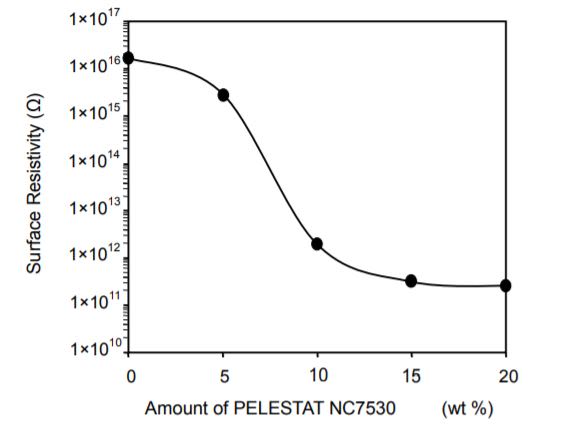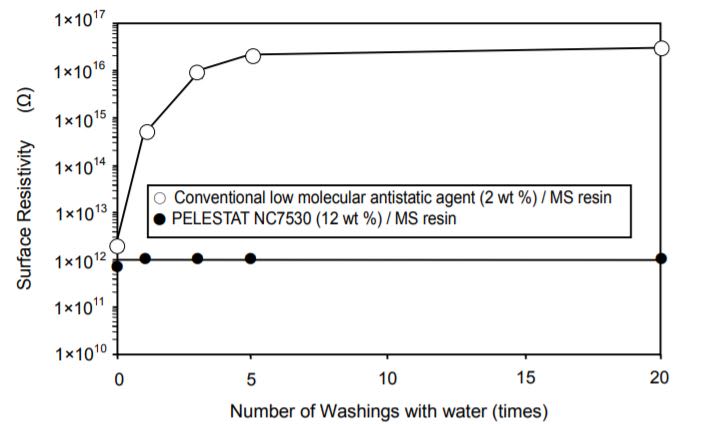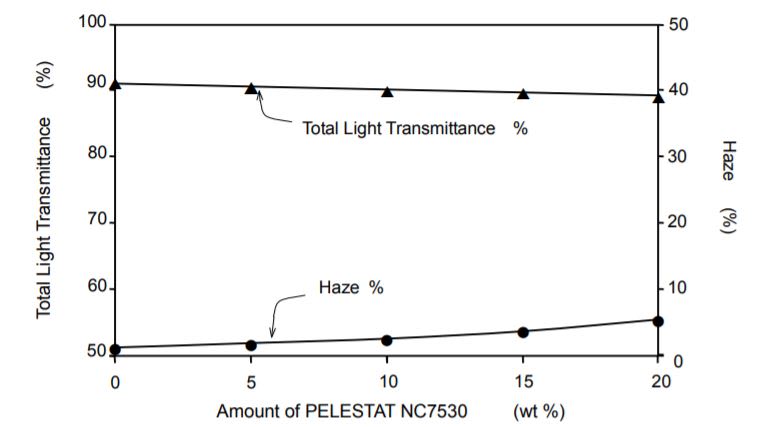Enhanced TDS
Knowde-enriched technical product data sheet
Identification & Functionality
- Chemical Family
- Plastics & Elastomers Functions
- Technologies
- Product Families
Features & Benefits
- Materials Features
- Features
PELESTAT NC7530 has the following features:
- Imparts an excellent antistatic property to styrene resins when the amount added is between 10 and 15 wt %.
- Exhibits a permanent antistatic property immediately after molding. The antistatic propertyin the resulting plastic minimally changes even after washing with water because it is a high-molecular weight antistatic agent. In addition, it works even in low humidity due to its low dependency on humidity. It also minimally affects the mechanical and surface properties of the styrene resins themselves.
- Minimally affects the transparency of the MS resin with a refractive index of 1.53.
- Does not impair the heat resistance of resulting plastic because this product is thermally stable.
- Applicable to electric and electronic parts due to its low-content of halogenated compounds.
Applications & Uses
- Markets
- Applications
- Compatible Polymers & Resins
- Plastics & Elastomers End Uses
- Plastics & Elastomers Processing Methods
- Application Methods
1. General Procedure
As shown in Figure 1, PELESTAT NC7530 and styrene resins such as MS resins are
dry-blended using a blender, and are kneaded using a twin-screw extruder and pelletized.
Pigments can be added during the dry-blending or the kneading process if necessary.
The pelletized material is then molded into the final product using an appropriate molder
(e.g., injection molding machine).
Figure 1. General Procedure for Application of PELESTAT NC7530
2. Amount to be Used The standard amount of PELESTAT NC7530 is between 10 and 15 wt %. Determine the optimal amount by referring to the results of its performance tests.
3. Kneading Conditions Use a high share rate kneader (e.g., twin-screw extruder) when this product is kneaded. The standard kneading temperature is between 200 and 250 °C (392 – 482 °F). Determine the kneading temperature according to the resin applied.
4. Control Usage of PELESTAT NC7530
- This product can be immediately used after the sealed package is opened because this product is packaged under moisture-proof conditions.
- Drying is necessary when the sealed package is kept unsealed for a long time or when small bubbles form in the molding processes because this product has some hygroscopic properties as described in Figure 2.
The following are examples of the conditions for drying.
Drying under reduced pressure Vacuum Below 1300 Pa (0.2 psi) Temperature 70 – 80 °C (158 – 176 °F) Duration 2 – 4 hours Hot-air drying Temperature 70 – 80 °C (158 – 176 °F) Duration 2 – 4 hours 
Figure 2. Hygroscopic Properties of PELESTAT NC7530
Precaution Against Mishandling
- In the case of using resins at molding temperatures at 200 °C (392 °F) or lower, PELESTAT NC7530 may not fuse, possibly resulting in poor effectiveness. Furthermore, in case of using resins at molding temperatures above 280 °C (536 °F), this product may thermally decompose, possibly resulting in poor effectiveness. The recommended molding temperature is between 200 and 250 °C (392 – 482 °F).
- Depending on the kind of resin, this product may have an influence on the resin's physical properties such as mechanical properties. Test their influence on each other’s physical properties beforehand to ensure that there are no problems.
- Examples of Applications
PELESTAT NC7530 has been used as a permanent antistatic agent in MS resins in the following applications:
- Trays and containers for electric and electronic parts, etc.
- Lighting fixture covers, meter panels, etc.
- Various storage cases, etc.
Properties
- Physical Form
- Appearance
- Pale yellow pellet
- Typical Properties
Value Units Test Method / Conditions Melt Flow Rate (at 215°C 419°F, 21.18 N) approx. 10 g/10min ASTM D 1238 Melting Point (0.5 wt % formic acid solution at 25°C, 77 °F) approx. 176 (349) °C(°F) - Reduced Viscosity approx. 1.3 - DSC, ASTM D 3418 Refractive Index (at 23°C 73°F) approx. 1.53 - ASTM D 542 Surface Resistivity approx. 2 × 10^9 Ω ASTM D 257 Thermal Degradation Temperature approx. 280 (536) °C(°F) -
Regulatory & Compliance
- Patent Registered
USP 5,652,326 EP 0,613,919 USP 5,886,098 TW NI - 83,929 USP 5,604,284 KR 300,273
Technical Details & Test Data
- Performance Tests
The examples on pages 4 to 7 are the results of performance tests using MS resins mixed with PELESTAT NC7530. This product imparts a permanent antistatic property to MS resins that cannot be attained by any other conventional blend-type, low-molecular-weight antistatic agents. Furthermore, this product minimally affects the physical properties of MS resins because this product is highly compatible with them.
1. Application to MS Resins
A. Relationship Between Amount of PELESTAT NC7530 and Resulting Surface Resistivity The MS resin containing PELESTAT NC7530 is highly antistatic when the amount of this product added is between 10 and 15 wt %. Refer to Figure 3 and determine the optimal amount according to the desired surface resistivity.
Amount of PELESTAT NC7530 (wt %)
Figure 3. Relationship Between Amount of PELESTAT NC7530 and Surface Resistivity
Materials and Methods:
Materials:
A predetermined amount of PELESTAT NC7530 was dry-blended with the MS resin and the mixture was kneaded using a twin-screw extruder at approx. 220 °C (428 °F). The kneaded compound was then molded using an injection molding machine [nozzle temperature: approx. 210 °C (410 °F), mold temperature: approx. 60 °C (140 °F)] into samples 2 mm (approx. 0.08 inches) in thickness.
Method:
Each sample was kept at 23 °C (73 °F), 50 % R.H. for 24 hours. Then, the surface resistivity of each was measured using a megohmmeter according to ASTMD 257.B. Effect on Surface Resistivity When Repeatedly Washed with Water
(Evaluation of Durability of Antistatic Effect) The surface resistivity of the MS resin blended with PELESTAT NC7530 minimally changes, remaining
antistatic even when washed with water. This product imparts a permanent antistatic property that cannot be attained by any other conventional blend-type, low-molecular weight antistatic agents, which loses its antistatic property after being washed with water approximately three times.
Number of Washings with water (times)
Figure 4. Effect on Surface Resistivity When Repeatedly Washed with Water
Materials and Methods:
Materials:
PELESTAT NC7530 (12 wt %) / MS resin
PELESTAT NC7530 (12 wt %) was dry-blended with the MS resin and the mixture was kneaded using a twin-screw extruder at approx. 220 °C (428 °F). The kneaded compound was then molded using an injection molding machine [nozzle temperature: approx. 210 °C (410 °F); mold temperature: approx. 60 °C (140 °F)] into samples 2 mm (approx. 0.08 inches) in thickness. Conventional low-molecular-weight anionic antistatic agent (2 wt %) / MS resin A conventional blend-type, low-molecular-weight antistatic agent, a Sanyo Chemical product, was applied. These samples were prepared by using the method described above.
Method:
Each sample was submerged in water and their surfaces were rubbed with cotton cloth. The samples were dried under reduced pressure [133 Pa (0.02 psi)] at 70 °C (158 °F) for 2 hours and were kept at 23 °C (73 °F), 50 % R.H. for 24 hours. The surface resistivity was measured using a megohmmeter according to ASTM D 257. This process was repeated according to the number of washing with water as described in Figure 4.C. Effect on Resin Physical Properties
As shown in Table 1, PELESTAT NC7530 imparts a permanent antistatic property to the MS resin. The compatibility of this product with this resin is excellent, and the MS resin physical properties are minimally affected.Property Method
(ASTM No.)PELESTAT NC7530
(10 wt %) / MS ResinMS Resin Surface resistivity Ω D257 8 × 10^11 > 10^16 Melt flow rate
(10 min, 230°C, 98.07 N) gD1238 8 5 Tensile strength MPa (psi) D638 67 (9,700) 69 (10,000) Flexural modulus MPa (psi) D790 2,700 (392,000) 2,900 (421,000) Izod impact strength (notched) J/m (ft・lbf/in) D256 30 (0.56) 30 (0.56) Deflection temp. under load (1.82 MPa) °C (°F) D648 89 (192) 90 (194) Materials and Methods:
Materials:
Surface resistivity
PELESTAT NC7530 (12 wt %) was dry-blended with the MS resin and the mixture was kneaded using a twin-screw extruder at approx. 220 °C (428 °F). The kneaded compound was then molded using an injection molding machine [nozzle temperature: approx. 210 °C (410 °F); mold temperature: approx. 60 °C (140 °F)] into samples 2 mm (approx. 0.08 inches) in thickness.
Melt flow rate
PELESTAT NC7530 (12 wt %) was dry-blended with the MS resin and the mixture was kneaded using a twin-screw extruder at approx. 220 °C (428 °F), and used as samples.
Other mechanical properties
Samples were prepared under the same conditions described in Figure 4 except that the predetermined size described in ASTM was applied. MS resin was also molded under the same conditions.
Methods:
See the ASTM No. described in Table 1.
(The testing method for surface resistivity is described in Figure 3.)D. Relationship Between Amount of PELESTAT NC7530 and Resin Optical Property
PELESTAT NC7530 has a refractive index of approx. 1.53. When this product is added to MS resins (refractive index: 1.51 − 1.57), a MS resin with a refractive index of approx. 1.53 should be used so that this product minimally affects MS resin’s transparency.
Amount of PELESTAT NC7530 (wt %)
Figure 5. Relationship Between Amount of PELESTAT NC7530 and Resin Optical Property
Materials and Methods:
Materials:
A predetermined amount of PELESTAT NC7530 was dry-blended with the MS resin (refractive index: approx.1.53) and the mixture was kneaded using a twin-screw extruder at approx. 220 °C (428 °F). The kneaded compound was then molded using an injection molding machine [(nozzle temperature: approx. 210 °C (410 °F); mold temperature: approx. 60 °C (140 °F) ] into samples 2 mm (approx. 0.08 inches) in thickness.
Method:
The samples were kept at 23 °C (73 °F) and 50 % R.H. for 48 hours. Total light transmittance and haze were measured using a hazemeter according to ASTM D 1003.
Safety & Health
- Hazards Description
PELESTAT NC7530 is a polyether-polyolefin block copolymer.
Vapor or fume from molten material causes eye and nose irritation.
This product is for industrial use only.